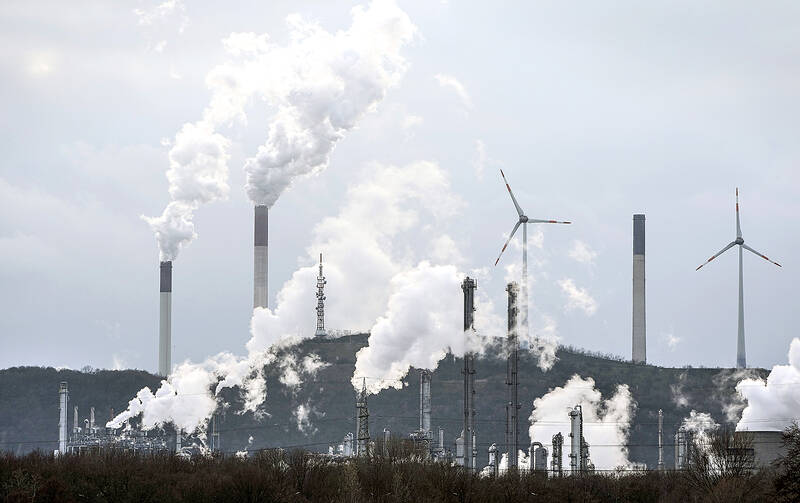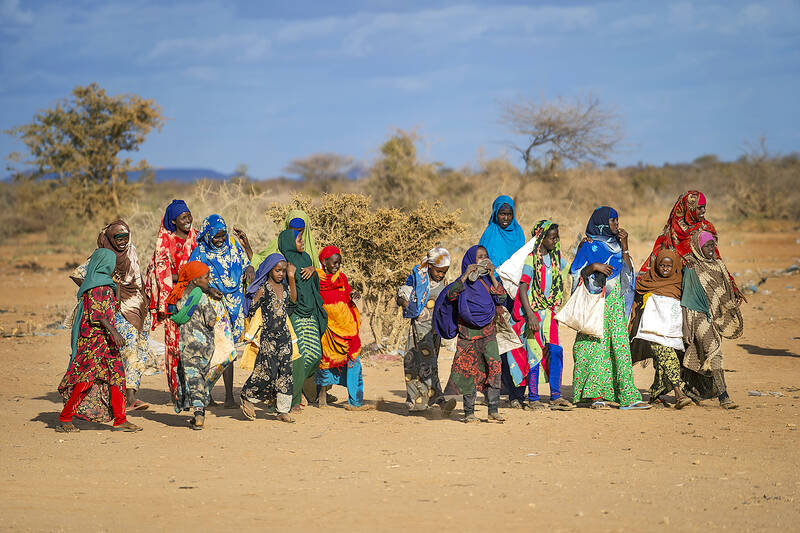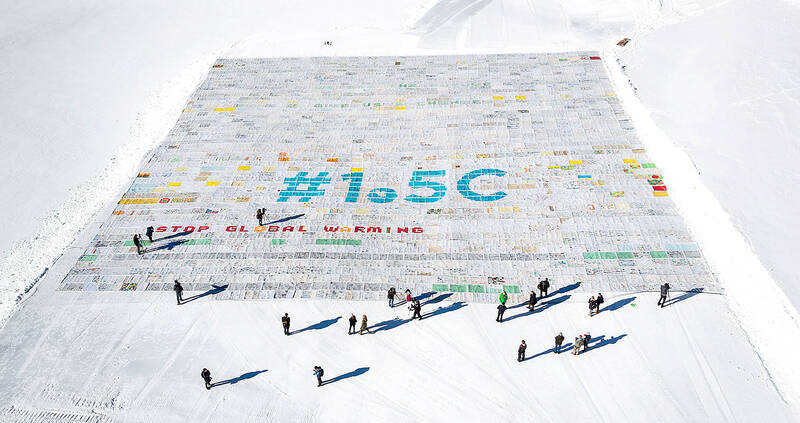Avoiding the worst ravages of climate breakdown is still possible, and there are “multiple, feasible and effective options” for doing so, the Intergovernmental Panel on Climate Change (IPCC) has said.
Hoesung Lee, chair of the body, which is made up of the world’s leading climate scientists, made clear that — despite the widespread damage already being caused by extreme weather, and the looming threat of potentially catastrophic changes — the future was still humanity’s to shape.
The IPCC reports show that humanity has the knowhow and the technology to tackle human-induced climate change. But not only that. They show that we have the capacity to build a much more prosperous, inclusive and equitable society in this process.

Photo: AP
“Tackling climate change is a hard, complex and enduring challenge for generations. We, the scientific community, spell out the facts of disheartening reality, but we also point to the prospects of hope through concerted, genuine and global transformational change,” Lee said.
FINANCE KEY
Finance would be key, he said. The shift to a low-carbon economy would take between three and six times the amounts of funding currently devoted to green investment, according to the final section of the IPCC’s comprehensive sixth assessment report (AR6) of human knowledge of the climate.

Photo: AP
Climate justice would also be vital, the IPCC said, because the people being hit hardest by the impacts of the crisis were the poorest and most vulnerable who have done least to cause the problem.
Aditi Mukherji, one of the 93 authors of the “synthesis report,” the final section that draws together the key findings, said: “Almost half the world’s population lives in regions that are highly vulnerable to climate change. In the last decade, deaths from floods, droughts and storms were 15 times higher in highly vulnerable regions.”
This positive framing of a report that makes mostly very grim reading was a deliberate counterblast to the many voices that have said the world has little chance of limiting global heating to 1.5C above pre-industrial levels, the threshold beyond which many of the impacts of the crisis will rapidly become irreversible.

Photo: AFP
Chris Jones, of the Met Office Hadley Center, a member of the report’s core writing team, pointed out that emissions fell by 6 percent in 2020 owing to the COVID-19 lockdowns, and a similar fall would be needed each year for the next decade.
“The scale of the challenge is massive,” he said. “If we keep emitting at the current rate, the carbon budget for 1.5C will be exhausted by 2030.”
Monday’s publication may be the last this decade from the IPCC, which was set up in 1988 to assess global knowledge of the climate and advise on how human actions have been changing it. The IPCC AR6 report, which was delayed slightly owing to the COVID-19 pandemic, was published in three main sections from August 2021 to April last year. The first three sections covered the underlying science of the climate system, the impacts of climate breakdown and the ways of tackling or reducing the problem, followed by Monday’s synthesis chapter drawing the previous three together.
IPCC scientists and climate experts emphasized that this decade would be crucial, as decisions made now would affect the future of the planet for hundreds and perhaps thousands of years.
Simon Stiell, the UN’s top climate official, said: “We are in a critical decade for climate action. Global emissions need to be reduced by nearly 43 percent by 2030 for the world to achieve the Paris agreement’s goal to limit global temperature rise to 2C and pursuing efforts to limit the temperature increase to 1.5C. The synthesis report highlights just how far off-track we are.”
But he added: “It’s not too late. The IPCC clearly demonstrates that it is possible to limit global warming to 1.5C with rapid and deep emissions reductions across all sectors of the global economy. It has given us many feasible, effective and low-cost mitigation and adaptation options to scale up across sectors and countries.”
ACTION, NOT DESPAIR
The message of action, rather than despair, was also taken up by the UN secretary-general, Antonio Guterres. He called for countries to adopt an “acceleration agenda” involving all of the G20, the world’s biggest developed and developing countries.
Developed countries must bring forward their commitments on reaching net zero greenhouse gas emissions, from 2050 to “as close as possible to 2040”, said Guterres.
Emerging economies, many of which have set net zero targets for the second half of this century, must also bring them forward, to “as close as possible” to 2050, he urged. This would require a major revision by some of the world’s biggest emitters: China currently has a target of before 2060, and India of 2070.
Guterres also called for developed countries to phase out coal by 2030, and all others by 2040. He called for no new licensing or funding of oil and gas projects, based on the findings of the International Energy Agency that all new oil and gas development must cease for the world to limit global heating to 1.5C above pre-industrial levels.
Achieving this will be a stretch, and many governments are likely to ignore these pleas, at least in the short term. Many experts were keen to point out that the price of renewable energy technology has fallen rapidly, making it a more attractive investment. But oil and gas companies have also been enjoying a record bonanza, and many are planning to reinvest the proceeds in more fossil fuels.

May 11 to May 18 The original Taichung Railway Station was long thought to have been completely razed. Opening on May 15, 1905, the one-story wooden structure soon outgrew its purpose and was replaced in 1917 by a grandiose, Western-style station. During construction on the third-generation station in 2017, workers discovered the service pit for the original station’s locomotive depot. A year later, a small wooden building on site was determined by historians to be the first stationmaster’s office, built around 1908. With these findings, the Taichung Railway Station Cultural Park now boasts that it has

The latest Formosa poll released at the end of last month shows confidence in President William Lai (賴清德) plunged 8.1 percent, while satisfaction with the Lai administration fared worse with a drop of 8.5 percent. Those lacking confidence in Lai jumped by 6 percent and dissatisfaction in his administration spiked up 6.7 percent. Confidence in Lai is still strong at 48.6 percent, compared to 43 percent lacking confidence — but this is his worst result overall since he took office. For the first time, dissatisfaction with his administration surpassed satisfaction, 47.3 to 47.1 percent. Though statistically a tie, for most

In February of this year the Taipei Times reported on the visit of Lienchiang County Commissioner Wang Chung-ming (王忠銘) of the Chinese Nationalist Party (KMT) and a delegation to a lantern festival in Fuzhou’s Mawei District in Fujian Province. “Today, Mawei and Matsu jointly marked the lantern festival,” Wang was quoted as saying, adding that both sides “being of one people,” is a cause for joy. Wang was passing around a common claim of officials of the People’s Republic of China (PRC) and the PRC’s allies and supporters in Taiwan — KMT and the Taiwan People’s Party — and elsewhere: Taiwan and

Six weeks before I embarked on a research mission in Kyoto, I was sitting alone at a bar counter in Melbourne. Next to me, a woman was bragging loudly to a friend: She, too, was heading to Kyoto, I quickly discerned. Except her trip was in four months. And she’d just pulled an all-nighter booking restaurant reservations. As I snooped on the conversation, I broke out in a sweat, panicking because I’d yet to secure a single table. Then I remembered: Eating well in Japan is absolutely not something to lose sleep over. It’s true that the best-known institutions book up faster